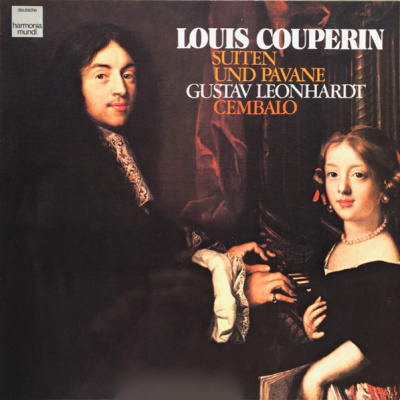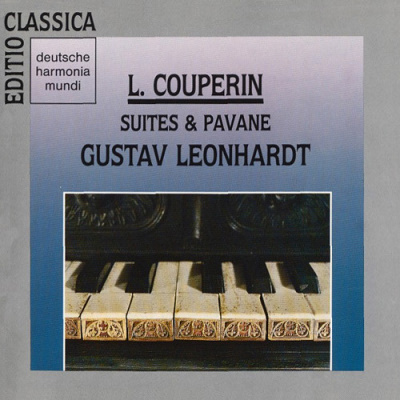 |
|
1 LP -
1C 065-99 871 - (p) 1980
|
 |
| 1 CD -
GD 77058 - (c) 1990 |
|
SUITEN UND
PAVANE
|
|
|
|
|
|
|
|
| Louis COUPERIN (ca.1626-1661) |
Suite
in a-moll |
|
18' 21" |
|
|
- Prélude à
l'imitation de Mr. Froberger
|
7' 04" |
|
A1 |
|
- Allemande
|
3' 23" |
|
A2 |
|
- Courante
La Mignonne
|
1' 18" |
|
A3 |
|
- Sarabande |
3' 01" |
|
A4 |
|
- Menuet |
1' 53" |
|
A5 |
|
- La
Piémontoise
|
1' 42" |
|
A6 |
|
Suite
in C-dur |
|
12' 32" |
|
|
- Prélude
|
3' 25" |
|
A7 |
|
- Allemande |
2'
59"
|
|
A8 |
|
- Courante |
1' 25" |
|
A9 |
|
- Sarabande |
1' 21" |
|
A10 |
|
- Chaconne |
3' 22" |
|
A11 |
|
Pavane
in fis-moll |
|
6' 48" |
B1 |
|
Suite
in F-dur |
|
18' 56" |
|
|
- Prélude
|
2' 40" |
|
B2 |
|
- Allemande
grave
|
4' 03" |
|
B3 |
|
- Courante
|
1' 10" |
|
B4 |
|
- Sarabande |
1' 22" |
|
B5 |
|
- Branle de
Basque
|
0' 44" |
|
B6 |
|
- Gaillarde |
0' 58" |
|
B7 |
|
- Chaconne |
2' 39" |
|
B8 |
|
- Tombeau de
Monsieur Blancrocher
|
5' 12" |
|
B9 |
|
|
|
|
|
Gustav LEONHARDT,
Cembalo (Martin Skowroneck, 1977,
in französischer Art nach einem
Modell um 1680)
Stimmung: ein Halbton unter
normal (mitteltönig)
|
|
|
|
|
|
Luogo
e data di registrazione |
|
Amsterdam (Holland) -
1979
|
|
|
Registrazione: live
/ studio |
|
studio |
|
|
Recording
Supervision |
|
P. Dery | W. Draga
|
|
|
Engineer |
|
Sonart, Milano
|
|
|
Prima Edizione LP |
|
Harmonia Mundi (EMI
Electrola) | 1C 065-99 871 | 1 LP
- durata 57' 34" | (p) 1980
|
|
|
Edizione CD |
|
Deutsche
Harmonia Mundi | LC 0761 |
GD 77058 | 1 CD - durata 57'
34" | (c) 1990 | ADD
|
|
|
Cover Art
|
|
Charles Couperin
(1638-1679), der Bruder und
Schüler von Louis Couperin. Das
Gemälde von Claude Lefèbre
(1632-1675) zeigt ihn mit der
Tochter des Malers. Mit freundl.
Genehmigung von Giraudon.
|
|
|
Note |
|
- |
|
|
|
|
Just as the
name “Bach” immediately
brings Johann Sebastian to
mind, upon hearing the name
“Couperin” we tend to think
of François, whose
achievements were so
noteworthly that even his
contemporaries called him
“the Great”. Like the Bachs,
however, the Couperins were
a large family, whose played
a dominant rôle in the
history of French music. Not
until recently, however, has
the founder of this musical
dynasty begun to emerge from
the shadow of his famous
nephew. Louis Couperin was
born in Chaumes-en-Brie
(about 50 km east of Paris)
in 1626. With his two
brothers François (born
around 1630) and Charles
(born 1638, the father of
François "the Great") he
grew up in the pastoral
setting of this small town.
The brothers seem to have
received their first
training in music from their
father, who was the
school-master and pastor,
and who probably gave them
organ lessons. Due to the
fact that a number of nobles
and court musicians had
country estates in the
vicinity of Chaumes, the
Brie was the scene of a
fairly lively musical life,
to which the three young
musicians probably owed a
great deal. On a certain
24th of July (probably in
the year 1652), they decided
to give their famous
neighbour Jacques Champion
de Chambonnières a little
serenade composed by Louis,
in honour of his name-day.
This initiative was to have
a decisive effect upon the
subsequent fate of the
family.
Chambonnières, the founder
of the French clavecin
school, was so impressed by
the performance and by the
unusual talent of the young
composer, that he
immediately took him under
his wing, put in a good word
for him at court and, as
early as 1653, helped him
secure the position of
organist at the church of
St. Gervais in Paris.
(François and Charles soon
followed Louis there, and
indeed this position
remained more or less in the
family until 1826). From
then on, Louis’ rise was
inevitable: under
Chambonnières’ guidance he
made such progress that he
had soon reached - or,
indeed, surpassed - the
level of his teacher. At the
same time, Chambonnières'
own light was beginning to
dim, and several of his
colleagues, jealous both of
his success in aristocratic
circles and his title,
schemed to get him removed
from his post as Court
Clavecinist in favour of his
pupil. They failed, however,
to reckon with Louis'
integrity: he refused
adamantly to have any part
of these intrigues; in fact,
this was probably the very
reason that the king decided
to grant him the Post of a
Court Violist.
Unfortunately, he was not to
enjoy his happiness for very
long: he died in mid-Oktober
1661, at the age of 35. His
musical career had lasted no
more than a decade, but in
this short span he had
created an oeuvre of
astonishing dimensions,
which secured him a
permanent reputation. Apart
from a few simphonies
for violas he left behind
some 200 pieces for organ
and (mainly) for
harpsichord. Most of these
were not published until
1936; and those which have
since then been discovered
are for the most part still
unpublished.
As far as we know - both ot
our primary sources seem to
be copies prepared by some
other hand - Louis Couperin
arranged these pieces by key
signatures. leaving it up to
the pertormers to pick
whichever they pleased tor
arrangement into suites. An
exception seems to have been
the préludes "non
mesurés", which in one
of our sources are grouped
together at the beginning.
Their unusual notation
(semibreves) with long ties
and no bar lines is directly
derivative from the
practice, common among
lutenists, of playing
rhythmically free prelude
music. They also show
clearly the influence of the
Italian style, and there is
no doubt that Froberger. who
was in Paris from 1650 to
1653, introduced Couperin to
the improvised character of
some of Frescobaldi‘s
toccatas. The lutenist
Blancrocher, who died in
1652 as the result ot
falling down a stair-case,
was honoured not only by his
colleague Denis Gaultier,
but also by Couperin and
Froberger, who followed the
common practice of composing
a tombeau as a sort
of musical monument. Louis
Couperin furthermore
honoured his German friend
with his A-minor prelude.
Although the dance movements
are for the most part based
on the standing formal
models, they are
nonetheless, with few
exceptions, marked by a
seriousness, a boldness of
harmony and a variety of
rhythms which place Louis
Couperin far above his
French contemporaries, on a
level altogether comparable
to that of his famous
nephew.
Jacques
Delalande
|
  |
|
|